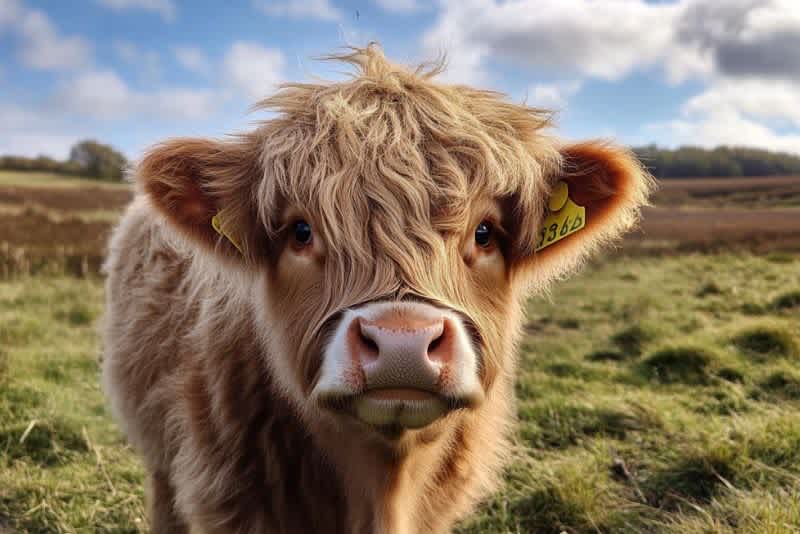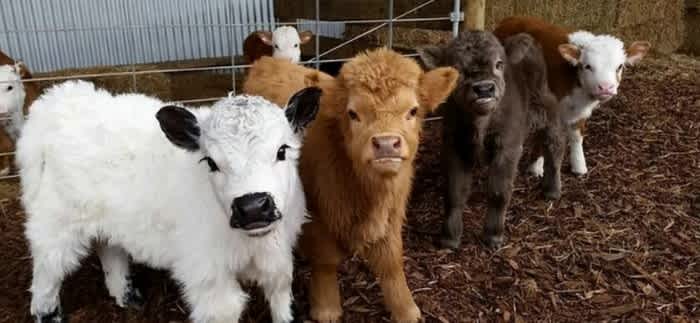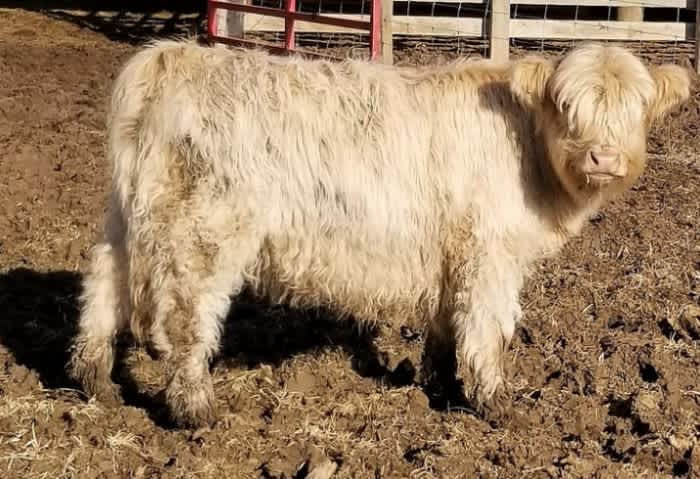Mini Highland Cows: Separating Fact from Fiction
Published: August 27, 2024

In recent years, a charming new trend has captured the hearts of animal lovers and aspiring farmers alike: Mini Highland cows. These pint-sized versions of the iconic Scottish Highland cattle have taken social media by storm, with their adorable fuzzy faces and compact stature sparking dreams of backyard farming for many enthusiasts.
The allure is undeniable. Who wouldn't want a cow that looks like an oversized teddy bear, small enough to keep in a suburban backyard? Images of these diminutive bovines grazing in manicured gardens or posing for selfies with their owners have fueled a growing interest in Mini Highland cows as pets or small-scale livestock.
However, as with any trending animal, it's crucial to separate fact from fiction. The reality of Mini Highland cows is more complex than what meets the eye in a carefully curated Instagram post. Understanding the truth behind these animals is essential not only for potential owners but also for the welfare of the animals themselves.
In this article, we'll get into the world of Mini Highland cattle, exploring their origins, the breeding practices involved, and the practical considerations of ownership. We'll examine the ethical implications of breeding for size and address the legal and care requirements that come with these unique animals.
Whether you're seriously considering adding a Mini Highland to your farm or simply curious about this bovine phenomenon, join us as we uncover the facts behind these captivating creatures. By the end, you'll have a clearer picture of what it really means to own and care for a Mini Highland cow, beyond the charm of their fluffy appearance.
The Highland Cattle Breed

Highland cattle, with their distinctive long horns and shaggy coats, have been an integral part of Scotland's rugged landscape for centuries. These hardy bovines trace their roots back to the 6th century, originating in the Scottish Highlands and Western Isles. Known as "kyloes" in Gaelic, they were bred to withstand the harsh climate and unforgiving terrain of their native land.
The breed's history is as rich as the Scottish soil itself. Highland cattle were once essential to the survival of Highland clans, providing not only meat and milk but also hides for clothing and shelter. Their ability to thrive on poor quality grazing and resist disease made them invaluable to early Scottish settlers.
Traditional Highland cattle are renowned for their imposing presence and unique characteristics:
Size / Shoulder Height: 35.4"–47.2" (90-120 cm)
Weight:
Males (bulls): 1500-2000 lb (680-910 kg)
Females (cows): 900-1200 lb (410-545 kg)
Coat: Their double coat consists of a long, shaggy outer layer and a downy undercoat, providing excellent insulation against cold and wet conditions.
Horns: Both males and females sport impressive horns, which can span up to 4 feet from tip to tip in mature animals.
Colors: While the tawny red coat is most iconic, Highland cattle can also be black, brindle, yellow, white, or dun.
These cattle are not just about looks; they're prized for their longevity, calving ease, and the quality of their beef. Highland cows can remain productive well into their late teens, with some continuing to calve into their early 20s – a testament to their robust health and fertility.
The breed's adaptability has led to its spread beyond Scotland, with Highland cattle now found in various parts of Europe, North and South America, and Australia. Their ability to convert rough forage into high-quality beef has made them popular among farmers looking for low-maintenance, hardy livestock.
Understanding the history and traditional characteristics of Highland cattle provides crucial context for any mini cattle trend. It raises important questions about how these smaller versions compare to their ancestral counterparts in terms of health, hardiness, and the very traits that have made Highland cattle so valued for centuries.
As we go deeper into the world of Mini Highlands, keep in mind the breed's rich heritage and the qualities that have allowed it to stand the test of time. This background will help us better appreciate the complexities surrounding the breeding and care of their miniature counterparts.
Breeding Practices and Controversies
The pursuit of miniature Highland cattle has sparked both innovation and controversy within the breeding community. As with any selective breeding program, the goal of creating smaller Highlands must be balanced against ethical considerations and the animals' overall health and well-being.

Ethical Breeding Methods
Responsible breeders focus on selective breeding techniques that prioritize the animals' welfare:
Careful selection of smaller parents within the breed standard
Gradual size reduction over multiple generations
Maintaining genetic diversity to avoid inbreeding
Regular health assessments and genetic testing
These methods aim to produce smaller Highlands while preserving the breed's essential characteristics and robust health.
Controversial Practices
Unfortunately, the demand for miniature livestock has led some breeders to employ questionable tactics:
Stunting growth: Some unethical breeders intentionally underfeed young cattle or provide a nutrient-deficient diet to restrict growth. This practice can lead to severe health issues and is widely condemned by reputable breeders and veterinarians.
Indiscriminate crossbreeding: Mixing Highland cattle with naturally smaller breeds may produce smaller offspring, but it can also result in animals that lack the Highland's distinctive traits and hardiness.
Breeding from runts: Consistently selecting the smallest animals for breeding, regardless of their overall health or conformation, can perpetuate genetic weaknesses.
Misrepresentation: Some breeders simply market young or underdeveloped Highlands as "miniature," misleading less savvy buyers about the animals' true adult size.
Genetic Considerations and Health Issues
The push for miniaturization can have significant genetic implications:
Reduced genetic diversity: Focusing on size alone can narrow the gene pool, potentially leading to increased susceptibility to diseases and genetic disorders.
Dwarfism: Some forms of dwarfism in cattle can result in serious health problems, including joint issues, respiratory difficulties, and reduced lifespan.
Reproductive challenges: Extremely small cows may have difficulty carrying and delivering calves safely, leading to increased veterinary interventions.
Loss of hardiness: Breeding primarily for size may inadvertently reduce the breed's renowned ability to thrive in harsh conditions.
Potential buyers should be aware that not all "mini" Highlands are created equal. Some may simply be younger or smaller examples of standard Highland cattle, while others might be the result of questionable breeding practices.
Prospective owners should thoroughly research breeders, ask for detailed health records and genetic information, and ideally, visit the farm to observe the breeding stock and living conditions. Reputable breeders will be transparent about their methods and prioritize the health and welfare of their animals over achieving the smallest possible size.
Pros and Cons of Owning Mini Highland Cattle
As with any livestock venture, owning Mini Highland cattle comes with its own set of advantages and challenges. Understanding these can help potential owners make informed decisions about whether these animals are right for their situation.

Benefits
Space Requirements: Mini Highlands require less pasture than their full-sized counterparts, making them an attractive option for small-scale farmers or hobbyists with limited land. A pair of Mini Highlands might thrive on as little as 1-2 acres, compared to 2-5 acres needed for standard Highlands.
Feed Efficiency: Due to their smaller size, Mini Highlands generally consume less feed than standard cattle. This can translate to lower ongoing costs for owners, especially in areas where quality grazing land is scarce or expensive.
Temperament: Highland cattle are known for their docile and friendly nature, and Mini Highlands often retain this pleasant disposition. Their smaller stature can make them less intimidating, but keep in mind, these are still cattle and should not be near children.
Versatility: Mini Highlands can serve multiple purposes on a small farm, providing milk, meat, and even acting as brush clearers on a more manageable scale than full-sized cattle.
Aesthetic Appeal: There's no denying the charm of these diminutive bovines. Their cute appearance can make them popular attractions for agritourism ventures or as unique pets for those with appropriate facilities.
Challenges
Health Concerns: Some Mini Highlands may be prone to health issues related to their breeding, particularly if they come from lines focused solely on size reduction. Potential problems can include:
Skeletal abnormalities
Digestive issues
Reduced cold tolerance compared to standard Highlands
Ethical Considerations: Owners must grapple with the ethical implications of supporting a breed that may have been developed through controversial practices. This can be mitigated by carefully selecting animals from reputable breeders who prioritize health over extreme miniaturization.
Legal Issues: Zoning laws in many areas may not distinguish between mini and full-sized cattle. Prospective owners need to thoroughly research local regulations regarding livestock ownership, which may restrict or prohibit keeping cattle in certain residential areas.
Limited Genetic Diversity: The gene pool for Mini Highlands is often smaller than that of standard Highlands, which can lead to challenges in maintaining herd health and finding unrelated breeding stock.
Specialized Care: While generally hardy, Mini Highlands may require specialized veterinary care. Finding a vet experienced with miniature cattle breeds can be challenging in some areas.
Market Uncertainty: The market for Mini Highland products (meat, milk, breeding stock) is less established than that for standard cattle, which could impact the economic viability for those looking to raise them commercially.
Misconceptions: Owners may face challenges educating others about their animals, as many people are unfamiliar with miniature cattle breeds. This can lead to misunderstandings about the animals' care requirements or purpose.
Pricing and Cost Considerations
Understanding the financial aspects of owning Mini Highland cattle is crucial for potential buyers. The costs associated with these animals can vary significantly based on several factors, and it's important to consider both the initial purchase price and ongoing expenses.
Price Range for Mini Highland Cows
The price range for mini Highland cattle can vary considerably:
Generally, mini Highland cows cost between $1,000 and $6,000.
Some breeders charge higher prices, with heifers starting at $6,000+ and bulls starting at $5,000+.
Micro or chondro-positive mini Highlands can be even more expensive, with heifers potentially starting at $8,000+.
It's worth noting that the market has seen significant fluctuations. Around 2019-2020, there was a huge spike in popularity, with some cows selling for up to $10,000. However, as supply catches up with demand, prices are expected to stabilize at more reasonable levels.
Factors Affecting Price
Several factors influence the price of mini Highland cows:
Age: Calves are typically less expensive than mature cows.
Gender: Heifers and bulls are usually pricier than steers.
Pedigree: Registered animals with superior lineage command higher prices.
Breeder reputation: Well-known breeders may charge more.
Color and markings: Unique or desirable coat patterns can increase price.
Estimated maturity height: Smaller projected adult size often increases value.
Chondro status: Chondro-positive animals (carriers of the dwarfism gene) are often more expensive.
Horn status: Polled (naturally hornless) animals may be priced differently.
Additional Costs
When budgeting for mini Highland cattle, consider these additional expenses:
Transportation: $200 to $1,000 or more, depending on distance and method.
Initial Setup:
Fencing: Costs vary widely based on acreage and materials used.
Shelter: From basic three-sided structures to more elaborate barns.
Water systems and initial supplies.
Ongoing Care: Feed, veterinary care, bedding, supplies etc.
Comparison to Standard Highland Cattle Prices
Mini Highlands are generally more expensive than their standard-sized counterparts:
Standard Highland calves: $500 - $2,000
Standard Highland heifers: $1,000 - $3,000
Standard Highland bulls: $2,000 - $5,000
This premium is often due to the novelty factor and perceived ease of management for smaller animals. However, it's important to note that the market for mini Highlands is less established, which can affect both purchase and resale values.
Remember, while the initial purchase price is important, the long-term costs of care and maintenance are equally important in determining the true cost of ownership. Careful budgeting and financial planning are essential for a successful and sustainable mini Highland cattle venture.
Care and Management

Proper care and management are crucial for the health and well-being of Mini Highland cattle. While they share many characteristics with their larger counterparts, their smaller size and potentially different genetic makeup require some specialized considerations.
Nutritional Needs
Mini Highlands, like standard Highlands, are efficient foragers, but their diet must be carefully managed to prevent obesity and ensure proper growth:
Pasture: High-quality grass should form the bulk of their diet. Rotational grazing helps maintain pasture quality and prevents overgrazing.
Hay: During winter or when pasture is limited, good quality hay is essential. Alfalfa can be used sparingly as it's high in protein and calories.
Grain: Minimal grain supplementation is typically necessary, except for lactating cows or in cases of nutritional deficiency.
Minerals: Free-choice access to a mineral block formulated for cattle is important, especially in areas with known mineral deficiencies.
Water: Clean, freshwater should always be available. Adult Mini Highlands may drink 5-10 gallons per day, depending on weather and diet.
Avoid overfeeding, as Mini Highlands can become obese more easily than standard cattle. Regular body condition scoring helps maintain optimal weight.
Housing and Space Requirements

While hardy, Mini Highlands still need proper shelter and adequate space:
Pasture: Allow 0.5 to 1 acre per animal for grazing, depending on pasture quality and management practices.
Shelter: Provide a three-sided shelter or barn access to protect from extreme weather. Despite their woolly coats, Mini Highlands can be more susceptible to cold than their full-sized relatives.
Fencing: Strong fencing is essential. While generally docile, Highlands can be escape artists. A combination of woven wire and electric fencing often works well.
Enrichment: Offer varied terrain and brush for natural behaviors like scratching and foraging.
Remember to provide separate areas for feeding and watering to prevent dominant animals from blocking access.
Health Care and Veterinary Considerations
Regular health maintenance is key to preventing issues:
Vaccinations: Consult with a veterinarian to establish an appropriate vaccination schedule for your area.
Parasite Control: Regular deworming and external parasite prevention are crucial. Be cautious with dosages, as Mini Highlands may require adjusted amounts based on their weight.
Hoof Care: Trim hooves as needed, typically 1-2 times per year. Some Mini Highlands may need more frequent trimming due to less natural wear.
Dental Care: Annual dental checks are recommended, as some mini breeds can be prone to dental issues.
Breeding Considerations: If breeding, be aware of potential calving difficulties due to smaller body size. Have an experienced veterinarian available for assistance.
Regular Check-ups: Schedule routine veterinary visits to catch any health issues early. Find a vet experienced with cattle, preferably one familiar with miniature breeds.
Monitoring: Daily observation is key. Look for signs of illness such as changes in appetite, lethargy, or unusual behavior.
When managing your Mini Highland herd, it's beneficial to keep detailed records of each animal's health history, breeding information, and any treatments administered. Modern cattle management software can streamline this process, making it easier to track individual animals and overall herd health.
For example, the Ranchr app allows you to store comprehensive health records, track vaccinations and treatments, and even set reminders for routine care tasks. This can be particularly useful for Mini Highland owners who may be new to cattle management and need to closely monitor their animals' health and development.
By providing attentive care and management, owners can help ensure their Mini Highlands lead healthy, comfortable lives. Remember that while these animals may be smaller, they still require significant commitment in terms of time, resources, and knowledge to thrive.

Owning Mini Highlands Responsibly
The allure of Mini Highland cattle is undeniable. Their charming appearance and compact size have captured the imagination of many aspiring cattle owners. However, as we've explored, the world of miniature Highlands is more complex than it might appear at first glance.
Ethical breeding practices are paramount to ensure the health and welfare of these animals. Prospective owners must navigate the murky waters of breed standards, potential health issues, and the ethical implications of supporting this emerging trend.
For those considering Mini Highlands or any miniature cattle breed, the importance of due diligence cannot be overstated. Research, consultation with experts, and honest self-assessment of one's capabilities and resources are essential steps in the decision-making process.
As we move forward, let's approach the Mini Highland trend with a balance of enthusiasm and responsibility. By doing so, we can help ensure that these captivating creatures receive the care and respect they deserve, preserving the best qualities of their Highland heritage in a pint-sized package.
Resources
The following resources can help you make informed decisions and connect with reputable sources in the Highland cattle community.
Reputable Breeders and Associations
American Highland Cattle Association (AHCA): As the official registry for Highland cattle in the United States, the AHCA is an invaluable resource. While they don't recognize a "mini" variant, they maintain a database of registered breeders and can provide information on Highland cattle standards and care.
Heartland Highland Cattle Association: Founded in 1994, this organization offers an open registry and has compiled breed standards for both Scottish and American Highland cattle. They can be a good source for connecting with experienced breeders and owners.
Mid-Atlantic Highland Association: For those in the eastern United States, this regional association provides localized information and networking opportunities with Highland cattle enthusiasts.
Highland Cattle Society: Based in Scotland, this is the original Highland cattle registry. Their resources on getting started with Highland cattle can be particularly helpful for understanding the breed's heritage and traditional characteristics.
Remember, responsible cattle ownership begins with thorough education and continues with ongoing learning and adaptation. By leveraging these resources and maintaining a commitment to ethical practices, you can contribute positively to the Highland cattle community, whether you ultimately choose standard or smaller-sized animals.
Related Articles:
Keep track of all your cattle with the #1 Cattle Management Software
Try out Ranchr today for free